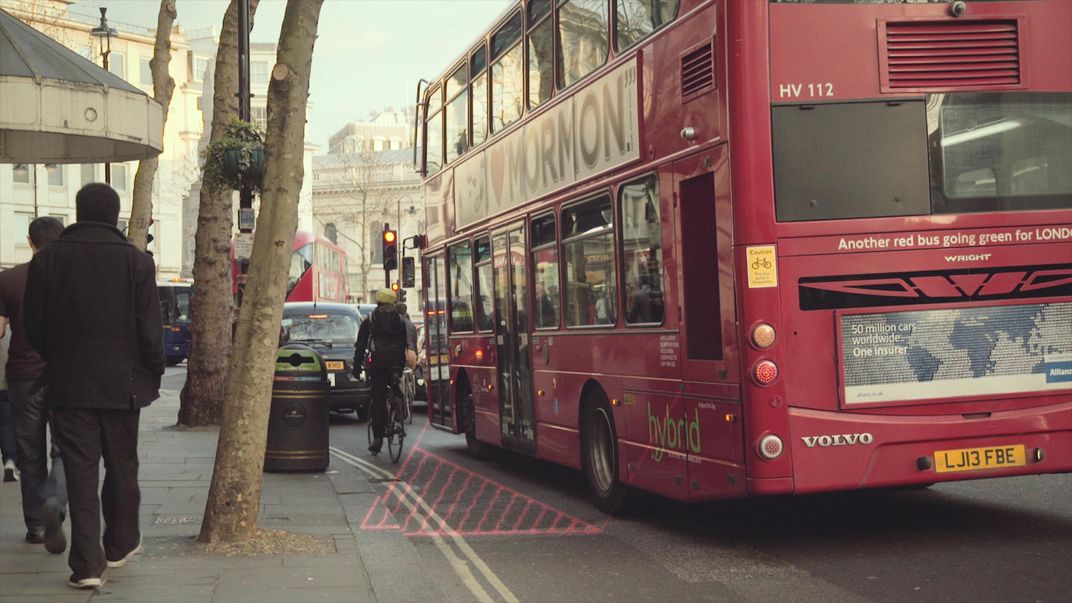Five Tech Ideas That Could Improve City Bike Commuting
A group of London designers imagines Google Glass-like visors and buses that project outlines of their blind spots on the road
/https://tf-cmsv2-smithsonianmag-media.s3.amazonaws.com/filer/0a/b1/0ab1a300-0432-4fdb-b815-7c26b476f6cc/11_augmented_paths_network.jpg)
What if, when you rolled up to a stop light on your bike, your helmet told you where to make your next turn, and gauged traffic to send you home the fastest, safest way.
That’s not out of the realm of possibility. A new project, Connected Cyclists, from Future Cities Catapult in London, is looking at ways that virtual reality, the internet of things and real time data can make streets and bikes paths safer and more useful for cyclists.
The team behind the project came up with five concepts, all rooted in machine-to-machine communication. The products address problems that city bikers face, including route finding and dodging buses. “If these displays talked to the city around them—if they knew where the cyclist was and what they were looking at—they could give much more subtle spatial and contextual information that builds on the surroundings of the cyclist,” says Claire Mookerjee, the project lead.
Two of the five concepts are head-up displays, or screens integrated into a helmet or glasses that give cyclists information within their field of vision, limiting the need to look away from the road. The first, a Google Glass-like display called the "augmented paths network" that can be installed in a visor or glasses, gives a biker directions, much like Google Maps. But the cues show up in front of the user's eyes instead of on a phone, and they adapt based on traffic. The second, which would function in a similar way, uses landmarks and other visual markers to guide the wearer instead of street signs.
The third tool, an app, looks at air quality using real time data funneled from another Future Cities project, Sensing Cities, and guides a cyclist to the least polluted route possible. Mookerjee says her team also thinks that, because pollution tends to be concentrated in busy areas, it will ease traffic by getting cyclists on to less congested side roads. The fourth is a sensor that is placed on the side of buses to help avoid collisions with cyclists. Accidents often happen when bikers are in buses' blind spots. The sensor uses sonar and proximity sensing to detect an oncoming cyclist and project lines on the road that indicate the vehicle's blind spot, so the biker can stay out of the way. The last idea, a sensor installed in bike share bikes, helps cyclists find the nearest bike sharing station with available rides. GPS in the bikes and in the stations would communicate with each other.

Future Cities Catapult is a design lab, funded by the UK's Technology Strategy Board, that focuses on using data and tech to make cities function more smoothly. As cities invest time and resources into building bike programs, the group decided to devote some energy to smart commuting designs.
"We made them to provoke dialogue, a way of thinking about technology in the city, and to engage people in a richer discussion about how we need to think about the experience of cycling," says Mookerjee. Dan Hill, the chief design officer, says Connected Cyclist spends a lot of time talking to transportation providers in major cities, from New York to Dubai. Planners in those cities are primarily focused on hard infrastructure, like building bike lanes and bike share programs. But this team wants to focus on what they call soft infrastructure, or overlaying technology on existing physical networks to make them work better.
The group is keeping cyclists' eyes on the road and following their natural movements through the city with virtual reality. They think it can augment the experience of riding a bike, not distract from it in the way that looking at your phone for directions might do.
At this point, all of the ideas are still in prototype or concept phase. Similar head-up display goggles haven’t seen much traction in the skiing world, where they’ve already been introduced, so Connected Cyclist has work to do to make their speculative designs tenable. They want to make sure they have an audience and a use case. Hill says he thinks the prototypes are workable, and that the next steps will be testing and bringing them to market.
"Turning them into products that are viable, desirable and feasible is not trivial, and we know that execution is all,” he says. “Yet the core technologies exist, and are more or less at the right stage of development, price point, interoperability and so on. The ideas are not exactly science fiction.”
/https://tf-cmsv2-smithsonianmag-media.s3.amazonaws.com/accounts/headshot/DSC_0196_2.JPG)
/https://tf-cmsv2-smithsonianmag-media.s3.amazonaws.com/accounts/headshot/DSC_0196_2.JPG)